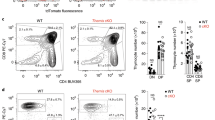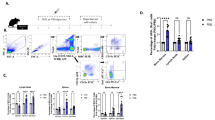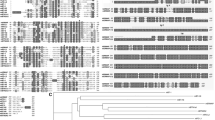Abstract
THE APO-l/(Fas/CD95) cell surface receptor is a member of the nerve growth factor (NGF)/tumour necrosis factor (TNF) receptor superfamily and mediates apoptosis1 –4. Peripheral activated T cells (ATC) from lymphoproliferation (Ipr/lpr) mutant mice that express a reduced number of APO-1 receptors have a defect in T-cell receptor (TCR)-induced apoptosis5,6. This suggests that TCR-induced apoptosis involves APO-1. We tested this hypothesis in various human T cells: (1) malignant Jurkat cells, (2) an allo-reactive T-cell clone (S13), and (3) peripheral ATC. TCR triggering through immobilized anti-CD3 antibodies or Staphylococcus enterotoxin B (SEB) superantigen induced expression of the APO-1 ligand and apoptosis in these cells. Anti-CD3-induced apoptosis of Jurkat cells was demonstrated even in single-cell cultures. In all cases apoptosis was substantially inhibited by blocking anti-APO-1 antibody fragments and soluble APO-1 receptor decoys. The APO-1 ligand was found in the supernatant of activated Jurkat cells as a soluble cytokine. We propose that TCR-induced apoptosis in ATC can occur through an APO-1 ligand-mediated autocrine suicide. These results provide a mechanism for suppression of the immune response and for peripheral tolerance by T-cell deletion.
This is a preview of subscription content, access via your institution
Access options
Subscribe to this journal
Receive 51 print issues and online access
$199.00 per year
only $3.90 per issue
Buy this article
- Purchase on Springer Link
- Instant access to full article PDF
Prices may be subject to local taxes which are calculated during checkout
Similar content being viewed by others
References
Trauth, B. C. et al. Science 245, 301–304 (1989).
Yonehara, S., Ishii, A. & Yonehara, M. J. exp. Med. 169, 1747–1756 (1989).
ltoh, N. et al. Cell 66, 233–243 (1991).
Oehm, A. et al. J. biol. Chem. 267, 10709–10715 (1992).
Watanabe-Fukunaga, R., Brannan, C. I., Copeland, N. G., Jenkins, N. A. & Nagata, S. Nature 356, 314–317 (1992).
Russell, J. H., Rush, B., Weaver, C. & Wang, R. Proc. natn. Acad. Sci. U.S.A. 90, 4409–4413 (1993).
Russell, J. H. & Wang, R. Eur. J. Immun. 23, 2379–2382 (1993).
Ramsdell, F. et al. Eur. J. Immun. 24, 928–933 (1994).
Takahashi, T. et al. Cell 76, 969–976 (1994).
Lynch, D. et al. Immunity 1, 131–136 (1994).
Gillette-Ferguson, I. & Sidman, C. L. Eur. J. Immun. 24, 1181–1185 (1994).
Dhein, J. et al. J. Immun. 149, 3166–3173 (1992).
Vignaux, F. & Golstein, P. Eur. J. Immun. 24, 923–927 (1994).
Rouvier, E., Luciani, M. F. & Golstein, P. J. exp. Med. 177, 195–200 (1993).
Ju, S.-T., Cui, H., Panka, D. J., Ettinger, R. & Marshak-Rothstein, A. Proc. natn. Acad. Sci. U.S.A. 91, 4185–4189 (1994).
Hanabuchi, S. et al. Proc. natn. Acad. Sci. U.S.A. 91, 4930–4934 (1994).
Stalder, T., Hahn, S. & Erb, P. J. Immun. 152, 1127–1133 (1994).
Lowin, B., Hahne, M., Mattmann, C. & Tschopp, J. Nature 370, 650–652 (1994).
Klas, C., Debatin, K.-M., Jonker, R. R. & Krammer, P. H. Int. Immun. 5, 625–630 (1993).
Nicoletti, I., Migliorati, M. C., Grignani, F. & Riccardi, C. J. J. immun. Meth. 139, 271–279 (1991).
Kabelitz, D., Conradt, P., Schondelmaier, S., Wagner, H. & Haas, R. J. exp. Med. 170, 559–569 (1989).
Suda, T., Takahashi, T., Golstein, P. & Nagata, S. Cell 75, 1169–1178 (1993).
Peppel, K., Crawford, D. & Beutler, B. J. exp. Med. 174, 1483–1489 (1991).
Haight, F. A. Handbook of the Poisson Distribution (Wiley, New York, 1967).
Debatin, K.-M., Süss, D. & Krammer, P. H. Eur. J. Immun. 24, 753–758 (1994).
Author information
Authors and Affiliations
Rights and permissions
About this article
Cite this article
Dhein, J., Walczak, H., Bäumler, C. et al. Autocrine T-cell suicide mediated by APO-1/(Fas/CD95). Nature 373, 438–441 (1995). https://doi.org/10.1038/373438a0
Received:
Accepted:
Issue Date:
DOI: https://doi.org/10.1038/373438a0
This article is cited by
-
FOXP3 protects conventional human T cells from premature restimulation-induced cell death
Cellular & Molecular Immunology (2021)
-
Rethinking peripheral T cell tolerance: checkpoints across a T cell’s journey
Nature Reviews Immunology (2021)
-
A small peptide antagonist of the Fas receptor inhibits neuroinflammation and prevents axon degeneration and retinal ganglion cell death in an inducible mouse model of glaucoma
Journal of Neuroinflammation (2019)
-
CD146 T cells in lung cancer: its function, detection, and clinical implications as a biomarker and therapeutic target
Cancer Cell International (2019)
-
Fas signaling-mediated TH9 cell differentiation favors bowel inflammation and antitumor functions
Nature Communications (2019)
Comments
By submitting a comment you agree to abide by our Terms and Community Guidelines. If you find something abusive or that does not comply with our terms or guidelines please flag it as inappropriate.



